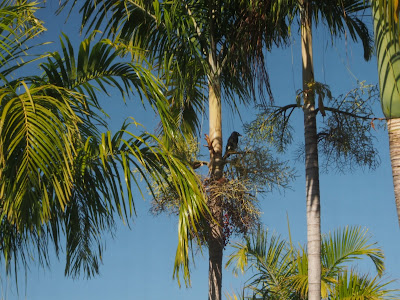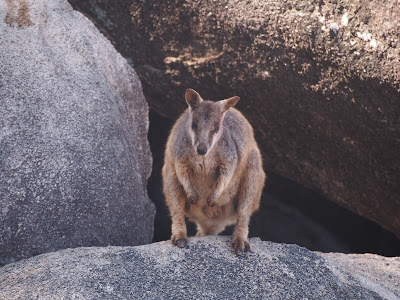Magnetic Island
More than half of this tropical island in Far North Queensland is a national park. And it really is protected and preserved, because there are no paths or tracks into it. There are a few walking tracks into the edge of the park but none that enable you to explore the interior.
I recently had a week's holiday in this wonderful place. Wildlife, bush, coral reefs - a perfect mix for a perfect nature fix.
These birds are called Bush Stone Curlews. They're nocturnal, and their calls are loud screams. We saw lots of them on the island. When scared, they run really fast. Apparently they can fly, but they are ground dwellers. They are only found in Australia, and mostly in the north.
This Humpback Whale was accompanied by its calf, that was swimming closely alongside. It would have migrated from its summer feeding grounds near the poles, to breed in the warmer waters near the Equator.
We took a boat trip round the island, and were given the opportunity to feed and photograph this Gold Spotted Cod. This species is common on the Great Barrier Reef.
 |
| Yellow Fusiliers |
 |
| Yellowtail Angelfish |
Walking along the beach I saw these tiny balls of sand. They were made by the Sand Bubbler Crab, a tiny crab only 1 cm wide, living in tiny holes in the sand. When the tide comes in, the sand balls are washed away. When the sea retreats again, they dig themselves out of their burrows, use their claws to scoop up sand, put it in their mouths, suck out the nutrients and discard the rest as perfectly round balls.
 |
When I was there, there were no crabs to be seen. They must have all been tucked up safely in their burrows. This photo, from Wikipedia, shows what the tiny crab looks like.
.The edible Kapok flowers signal the dry season, the leaves and cotton wool-like seed pods, the wet season. Aborigines and early settlers used the cottony fibres for bedding.
You can't walk for miles along the beach because the island consists of bays separated by cliffs and bush. This is part of the walk from Horseshoe Bay to Balding Bay, a nudist beach.
Large granite boulders are a feature of the island.
Hoop Pines grow in cracks in and between boulders. These trees were logged heavily in the early days of European settlement, so there aren't as many as there were.
Livistona australis, also known as Cabbage Tree Palms, are commonly seen on the island, in this case providing a perch for a Pied Currawong (Stepera graculina).
There is a colony of cute rock wallabies on the island. They are called Allied Rock Wallabies (Petrogale assimilis), a species endemic to Queensland. They are quite tame as tourists like to feed them. But the local Parks and Wildlife Office ask you not to feed them or, if you must, don't feed them bread because eating bread can lead to gum disease. Healthy wallaby food includes carrots, sweet potatoes, rock melon, apples and paw paw. But when they forage for themselves they eat grass and the shoots of herbaceous plants.
The one in the middle has a joey in its pouch. Gestation is about one month, then the joey spends the next six or seven months in the pouch where there are teats. They are fully weaned at around a year old.
See the Rock Wallaby on the left of the dead tree?
Another Pied Currawong.
Calliandras, flowering shrubs, are native to the tropical regions of the United States and Mexico. They do very well in the dry tropics of Australia as well, and we saw lots of them on Magnetic Island. For obvious reasons their popular name is Powder Puff. I think this one is C. haematocephala, or Red Powder Puff tree.
This is a breeding pair of Blue-winged Kookaburras - see the second bird in the tree hollow? They share the incubation of the eggs and subsequent feeding, that takes about two months. Blue-winged kookaburras are native to northern Australia and southern New Guinea. They are a bit smaller than the Laughing Kookaburras that I'm familiar with from southern Australia. They also have a very distinctive and very different call to the Laughing Kookaburra, that sounds like this ...
There is a terrible drought in this part of the world, and as one local put it, "the bush is hurting." This place is usually a swamp and full of birdlife, but last year they had no wet season, the bush is dry and dusty, and thirsty birds have to look elsewhere for a drink.
These are the fruits of the Cocky Apple tree (Planchonia careya), a common tree in tropical northern Australia. Aborigines eat the fruit, use many parts of the plant for medicinal purposes, and make boomerangs from the wood.
Pandanus cookii, aka Cook's Screw-Pine, is not a pine tree. It's a tropical tree related to palms, found all along the Queensland coast. These fruit are immature. When they are ripe, they will turn orange.
I've enlarged this photo so you can see the Green Tree Ants. These ants build nests by sticking leaves together. They're very territorial and aggressively defend their territory by biting anything that comes near, including spiders, birds, snakes and humans. They're very common round here. I'm glad they're not in my garden at home.
The Common Crow Butterfly, or Oleander Butterfly, is found in Queensland and northern New South Wales, but has been found in other places in Australia as well. An interesting characteristic of this butterfly is that it has a strong scent to make predators identify it as inedible. They also produce toxins that induce vomiting in some birds if they eat them.
The Blue Tiger Butterfly - aka Tirumala hamata - is migratory. It breeds in rainforest in northern Australia, but adults fly as far south as Victoria. At times enormous numbers of these butterflies pass through Brisbane.
This possum is blind, and comes every night to Man Friday, the restaurant where it is fed. Even if the restaurant is closed someone will come in specially to make sure the possum doesn't go hungry.
For more about nature and gardening in this region, see Bernie's terrific blog Dry Tropics Gardening.


























This looks like an amazing trip Sue. What a wonderful collection of critters you ha e here. Thanks for sharing!
ReplyDeleteit was an amazing trip, it's one of my favourite places. So pleased you enjoyed the post.
DeleteThank you so much for this very interesting post about flora and fauna on Magnetic Island. You must have had a great holliday there.
ReplyDeleteNow I'm up to Dry Tropics Gardening blog.
Have a nice week!
Janneke
Hi Judy, so pleased you enjoyed it. So different to visiting castles, isn't it?
Deletewhat would a possum eat?
ReplyDeleteThe bush is hurting - SO sad!
It was terrible to see the bush so dry. They were feeding this possum fruit and veggie scraps from the kitchen, but in the wild possums eat leaves plus anything else they can get - but they're not carnivorous.
DeleteIt looks perfectly enchanting! Great job with the underwater photography! Wow, snorkeling along the Great Barrier Reef sounds like a dream come true. I thought the Calliandras looked familiar. I remember singing a song in grade school about the Kookaburra in the "Old Gum Tree." So, I have pleasant memories of those birds, even though I've never seen one live. Beautiful photos of the butterflies, too. Thanks for sharing highlights from your trip!
ReplyDeleteHi Beth, how wonderful that you learned that song in school. It's still a popular children's song here. I have seen and heard lots of kookaburras but this was the first time I'd seen - or heard of - the Blue Winged ones. They are such characterful birds, unfortunately not so many around now because of loss of habitat.
DeleteSuch an interesting post, thank you for sharing it with us. It looks to be a marvellous place to have a holiday. Your underwater photos are so good, snorkling must have been a wonderful experience.
ReplyDeletethe snorkelling was fabulous, but the photos were pretty hit and miss. It felt very different from the control you have when you're not underwater!
DeleteOn the path to the nudist beach, that great big rock on the left hand side of the trail looks like it has a lid. IF I could lift it, I wouldn't be able to resist a little sing song "Hellllooooooooo."
ReplyDeleteIt does look like a lid. I never saw it before. I don't think anyone was inside, if they were, they didn't say hello. (lol)
DeleteWhat a wealth of wildlife habitat to explore and enjoy! I enjoyed the recording of the Blue-winged Kookaburras - as much fun to listen to as it is to say their name! I had to take a second look at the Calliandras. It is a cousin to the beautiful, but very invasive mimosa tree here in Alabama. The Calliandras grow south of us, in Florida.
ReplyDeleteKookaburras are very characterful, both in sound and look. I didn't realize Florida is also tropical, I guess that's why Calliandras grow so well on Magnetic Island.
DeleteThose wallabies are so cute I can see where people would be tempted to get close but that's so detrimental to wild animals. I didn't realize Australia was experiencing a drought, too. Why is the island called Magnetic?
ReplyDeleteHi Tammy, thanks for asking. The traditional Aboriginal owners, the Wulgurukaba people, called it Yunbenun. Captain Cook named it Magnetic Island in 1770 when he thought the island affected the magnetic compass on his ship.
DeleteI hope you enjoyed holidaying in my city! We have had a terrible drought here, it is true. Not to fear though, hopefully a big wet season comes along this year and helps replenish everything that has died back. It is a shame you didn't get to see the bubble grabs. We nickname then ghost crabs here because when you shine a light on them at night they glow an eerie white. Did you try to cockyapple? They taste horrible haha!
ReplyDeleteHI Holly, great to hear from a local. I hope you get a good wet season this year. Down south we're bracing ourselves for a summer of heat, drought and fires. Next time I visit Maggie Island I'll go down to the beach at night with a torch to see the ghost crabs. I didn't eat a cockyapple because they didn't seem ripe - lucky - sounds like I didn't miss much!
DeleteWhat a fabulous Island with incredible views and such a diverse ecosystem of critters....we always sang about the Kookaburra but I have never seen one...how adorable.
ReplyDeleteyes, it is a fabulous island, there are many many fabulous nature spots in Australia. There is something special about kookaburras.
Delete